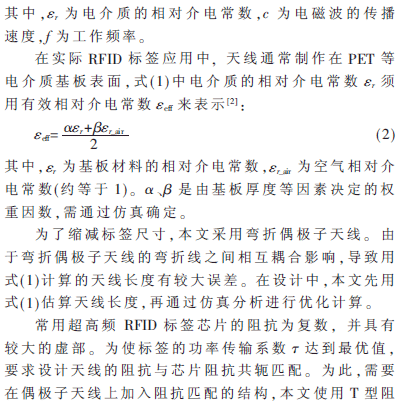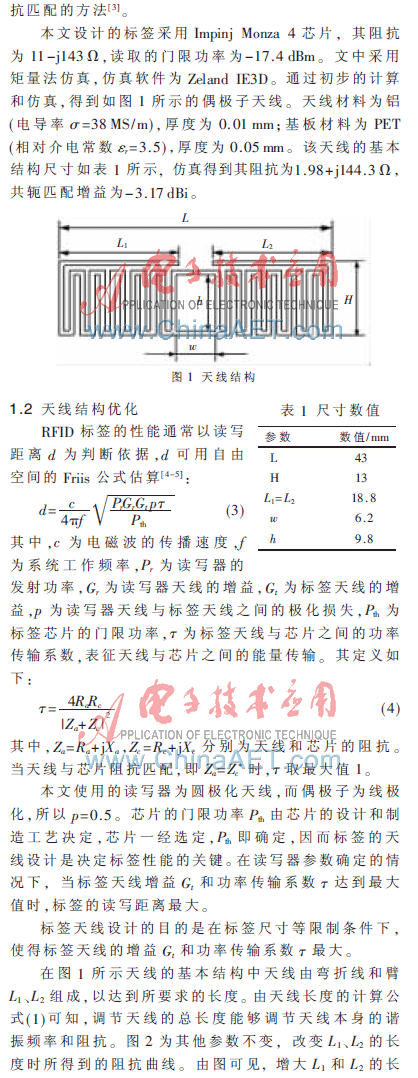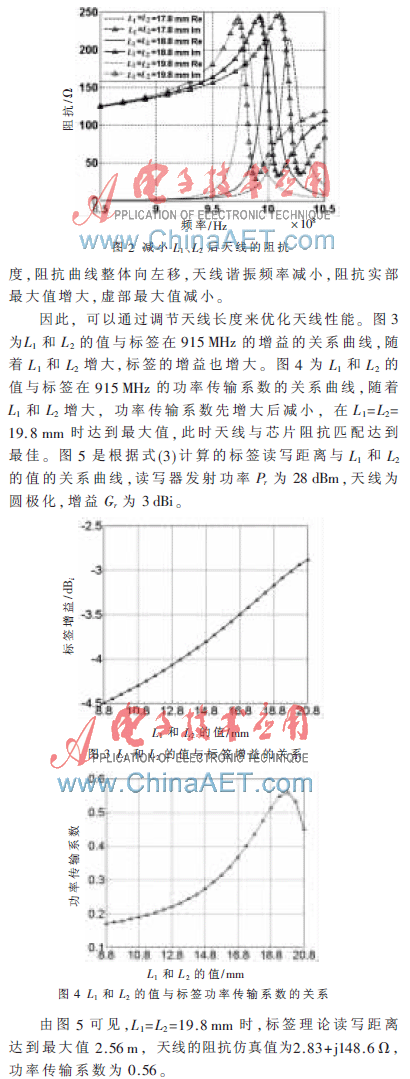文献标识码: A
文章编号: 0258-7998(2012)03-0117-03
射频识别RFID(Radio Frequency Identification)是一种非接触式自动识别技术,它通过射频信号自动识别目标对象并获取相关数据,识别工作无须人工干预,可工作于各种恶劣环境,被广泛应用于物流、防伪等领域。
RFID系统通常由读写器、标签和服务器组成。标签分有源标签和无源标签,无源标签由天线和芯片构成,结构简单,成本低。在超高频频段,标签天线常采用半波偶极子天线[1]。偶极子天线具有结构简单、效率高、制造成本低等优点。
1 偶极子天线设计
1.1 天线结构设计
由半波偶极子天线的定义,天线的总长度为工作频率下电磁波波长的1/2。结合电磁波在电介质中传播的波长公式,半波偶极子天线的长度La为:





4款样品天线分别选自天线优化设计的不同阶段,天线从773~776依次作了改进。从读取距离的测试结果可见,773~776的读取距离依次增加,天线776的读取距离最远,与仿真结果一致,可见本文所用的优化方法有效。
无源超高频RFID标签通常采用偶极子天线,本文采用理论分析和仿真优化相结合的方式设计了一款偶极子天线,并采用T型阻抗匹配结构实现与标签芯片的阻抗匹配。通过调节天线长度和阻抗匹配结构的尺寸对偶极子天线进行了优化, 并制作了4款小型超高频RFID标签样品。测试结果表明,4款样品标签的性能与预期的优化结果一致,优化后的标签读写距离达到1.59 m。
参考文献
[1] FINKENZELLER K. RFID handbook: fundamentals and applications in contactless smart cards, radio frequency identification and near-field communication[M]. 3rd ed. Hoboken, NJ: John Wiley & Sons Ltd., 2010.
[2] DEAVOURS D. UHF RFID antennas[M]. RFID Systems: Research Trends and Challenges, Bolic M, Simplot-Ryl D, Stojmenovic I, Hoboken, NJ:John Wiley & Sons, 2010, 57-98.
[3] MARROCCO G. The art of UHF RFID antenna design: impedance matching and size-reduction techniques[J]. IEEE Antennas and Propagation Magazine. 2008,50(1):1-21.
[4] RAO K V S, SANDER P V N. Antenna design for UHF RFID tags: a review and a practical application[J]. IEEE Transactions on Antennas and Propagation. 2005,53(12):3870-3876.
[5] TIKHOV Y. Comments on antenna design for UHF RFID tags a review and a practical application[J]. IEEE Transactions on Antennas and Propagation.2006,54(6):1906

